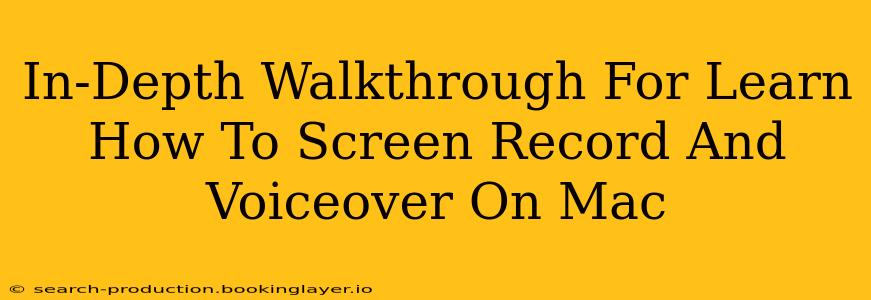Macs offer built-in tools for screen recording and adding voiceovers, making video tutorials, presentations, and software demos a breeze. This comprehensive guide will walk you through the process, covering various methods and tips for creating high-quality recordings.
Mastering QuickTime Player: Your Built-in Screen Recorder
QuickTime Player, a pre-installed application on every Mac, provides a surprisingly robust solution for screen recording and voiceovers. Here's how to use it:
Recording Your Screen with QuickTime:
- Open QuickTime Player: Locate it in your Applications folder or use Spotlight search.
- Start a New Recording: Go to "File" > "New Screen Recording".
- Choose Recording Options (Optional): A small control panel will appear. Click the dropdown arrow to select:
- Microphone: Choose your preferred microphone for your voiceover. If you don't want a voiceover, leave this selection as "None".
- Screen Recording Area: You can record the entire screen, a single window, or a custom selection.
- Start Recording: Click the red record button. A countdown will begin.
- Stop Recording: Once finished, click the stop button in the menu bar or press Command-Control-Esc.
- Save Your Recording: QuickTime will automatically prompt you to save your recording as a .mov file. Choose a location and file name.
Adding a Voiceover to Your QuickTime Screen Recording:
While QuickTime doesn't directly allow for simultaneous screen recording and voiceover editing, you can add a voiceover after recording using audio editing software like GarageBand (also pre-installed on Macs). This allows for greater flexibility in editing and refining your narration.
Exploring Other Screen Recording Options
Beyond QuickTime, several powerful third-party applications offer advanced features for screen recording and voiceover integration. Some popular choices include:
-
OBS Studio (Open Broadcaster Software): A free and open-source option with extensive capabilities, ideal for more complex recordings and live streaming. It allows for simultaneous screen recording and voiceover, multiple audio sources, and scene switching. Steeper learning curve than QuickTime, but offers incredible flexibility.
-
ScreenFlow: A paid application specifically designed for screen recording and video editing. It provides a user-friendly interface with numerous features including advanced editing tools, annotations, and built-in voiceover capabilities.
Tips for Professional-Looking Screen Recordings and Voiceovers:
- Use a good microphone: Clear audio is crucial. Invest in a decent microphone to ensure your voiceover is crisp and easily understandable.
- Plan your script: Outline your narration beforehand to ensure a smooth and coherent presentation.
- Edit your recordings: Remove any mistakes or unnecessary pauses in your recordings.
- Optimize your audio levels: Ensure your voiceover and screen recording audio are well-balanced and not too loud or quiet.
- Use visual aids: Enhance your screen recordings with visual cues like annotations or highlights to emphasize important information.
- Practice makes perfect: Don't be discouraged if your first attempts aren't perfect. The more you practice, the better you'll become.
Conclusion
Mastering screen recording and voiceover techniques on your Mac empowers you to create engaging and informative videos. Whether you use the simple built-in tools in QuickTime or explore the advanced features of third-party applications, understanding the fundamentals is key to producing high-quality content. Now you have the knowledge to start creating your own screen recordings with voiceovers! Remember to experiment and find the workflow that best suits your needs.

